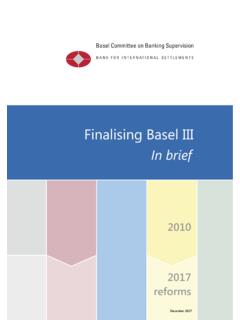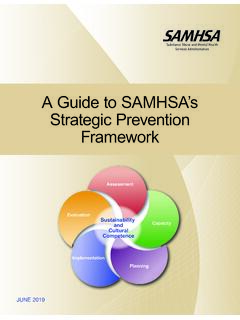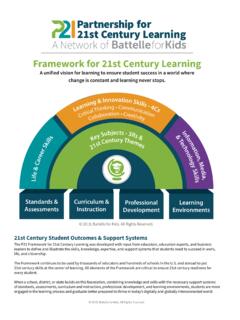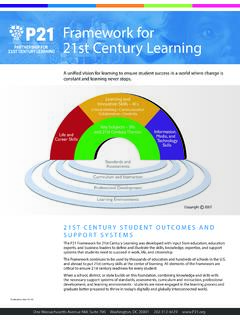Transcription of BRIEF BACKGROUND OF THE COMPETING VALUES …
1 BRIEF BACKGROUND OF THE. COMPETING VALUES framework (CVF) LEADING INNOVATION &. The COMPETING VALUES framework (CVF) emerged over twenty-five years ago GROWTH (LIG) SERIES. during research about organizational effectiveness and organizational culture and has since been validated by numerous studies. The concept of organizational effectiveness is deceptively simple to understand. How do we know if one organization is more effective than another? In order to answer this question, it is necessary to consider that not all organizations and organizational leaders will reach a consensus on what is means for their organization to be effective.
2 Furthermore, how do we assess the culture of an organization and know if one organization's culture differs from that of another organization? Organizational leaders regularly confront issues such as how to be innovative, how to organize and deploy resources, and how to collectively grow and change as a system. Leaders must then determine how to confront these and other issues while recognizing that effectively doing so within the scope of an organizational culture requires an awareness LIG 1 Leading Innovation Enterprise Program of the everyday tensions that exist within their organizations.
3 Thus, these LIG 2 Shared Vision & Jumpstart Program COMPETING positive tensions comprise the COMPETING VALUES framework . LIG 3 Black Belt Development Program LIG 4 Innovation & Growth Summit The horizontal axis (x-axis) of the CVF indicates a tension in organizational LIG 5 COMPETING VALUES Assessment focus as represented in a contrast between internal and person-oriented This series follows the principles of the COMPETING focus (toward the left) and external and organization-oriented focus VALUES framework (CVF).
4 The result of over 25 years (toward the right). The vertical axis (y-axis) indicates a tension in differing of academic research and testing, the CVF is a broadly applicable model that fosters successful perspectives on organizational structure as represented in a contrast leadership, improves organizational effectiveness between an interest in flexibility and change (toward the top) and an and promotes value creation. The premise of the CVF. interest in stability and control (toward the bottom). Each quadrant has two is that there are four basic COMPETING VALUES within every enterprise: Collaborate, Create, Compete and complementary quadrants (those on either side of it), and one quadrant to Control.
5 These VALUES compete in a very real sense which it is highly contrasted (the one directly diagonal to it). for a corporation's limited resources (funding, time, and people). How leadership responds to the tension created between these COMPETING VALUES will shape a CVF AND ORGANIZATIONAL OUTCOMES company's culture, practices, products, and ulti- mately, how they innovate and grow. Recognized by The assessment questionnaire has been developed around the CVF to the Financial Times as one of the 40 most important illustrate three dimensions the future outcomes (Purposes) that a company frameworks in the history of business, the CVF has desires to achieve; current organizational Practices; and the individual been implemented by hundreds of companies.
6 Leadership approach of each respective organizational member (People). TO LEARN MORE. Research shows that companies that are aligned among the dimensions of Visit or contact the Purposes, Practices, and People are much more effective than companies COMPETING VALUES Company directly at or 734-604-1012. without such alignment. The CVF illustrates the different tensions in the . 2. way in which effectiveness can be defined. A key message of the CVF is that despite the different ways for defining organizational effectiveness, it is important that companies are appropriately aligned in their respective definition of effectiveness.
7 Once aligned, companies can find their innovation sweet spot and achieve the growth outcomes that they desire. USES OF THE COMPETING VALUES ASSESSMENT. Individual Level Team Level Personal development. Team Development. Career planning. Creating a shared vision and shared VALUES Once the members of your entire company or strategic business unit complete the COMPETING VALUES Assessment, the aggregated assessment results can be compared to industry competitors by using the COMPETING VALUES Innovation Index. This index (an industry-specific ranking of companies) enables leaders to quickly understand companies positioned for growth in the marketplace and how their company compares to the competition.
8 Additionally, the Innovation Index shows how adjustments along the quadrants of the COMPETING VALUES framework will yield revenue to the company. These yields are based on over a decade's worth of validated statistical analysis, which demonstrates the value of the CVF for predicting financial performance. 3. THE ASSESSMENT EVALUATES THREE APPROACHES. TO CHANGE, INNOVATION, AND PURPOSES Outcomes, or value the organization intends to create. PRACTICES Culture, competency, and processes of the organization. PEOPLE You, and your personal VALUES , as a leader and as an individual.
9 IT THEN ALIGNS BEHAVIORS AND PRACTICES. WITH DESIRED RESULTS. PURPOSES Outcomes, or value the organization intends to create. PRACTICES Culture, competency, and processes of the organization. PEOPLE You, and your personal VALUES , as a leader and as an individual. 4. IF YOU ARE A YELLOW (COLLABORATE QUADRANT) . The Collaborate quadrant is a human relations model that emphasizes cohesion, morale, human resources, and training. This quadrant represents a cross between an internal, person-oriented focus and a flexible, change-oriented organizational structure.
10 Organizations that are anchored in this quadrant nurture their people, cultivate human capital, and are adaptive in their actions in that they focus on long-term development. Leader types: Facilitator, mentor, and team builder. value drivers: Commitment, communication, and development. Theory of effectiveness: Human development and high commitment produce effectiveness. Culture type: Clan. Metrics associated with the Collaborate quadrant: Knowledge Future growth VALUES , the difference between the firm's current market value and its market value if its profits did not grow.






